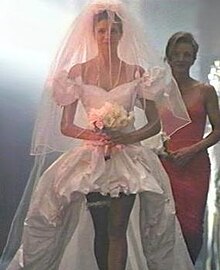Music videos demonstrate genre characteristics
 This genre of music is alternative rock; a sub-genre of rock. The stereotypical characteristics and conventions of this genre, in terms of a music video, are performances from the artist throughout the text. This is evident in this video for 'A Town Called Hypocrisy', where the band are seen performing the song using their allocated instruments on the set of the video.
This genre of music is alternative rock; a sub-genre of rock. The stereotypical characteristics and conventions of this genre, in terms of a music video, are performances from the artist throughout the text. This is evident in this video for 'A Town Called Hypocrisy', where the band are seen performing the song using their allocated instruments on the set of the video. Relationship between lyrics and visuals
Throughout this video, there are references to the lyrics that are featured within the video. The general lyrics during the song refer to the idea of not letting people tell you how to live your own life, which is shown in this video, where the band are seen partying and causing anarchy on the set of a children's television show.
 Frequent reference to the notion of looking, as well as voyeurism towards females
Frequent reference to the notion of looking, as well as voyeurism towards femalesDuring this text, the idea of voyeurism towards females is used widely. The idea of a contrast from the safe, well-behaved and respectful manner of a children's television show, to the females being in their underwear partying with the band is largely evident in this piece.
This aspect of this technique is used in music videos to promote the idea of sex in media. This attracts both males and females. This is mainly due to the fact it is included in the basic needs of the human life, and is available just by watching a 4 minute video. Sex is used in media to promote the idea of fun, as well as attracting audiences to make the video more successful.
Intertextual references
 This video has various intertextual references. Firstly, the idea of the band being hosts for a children's television show is contrasting to the hectic and youthful goings on once the cameras have stopped filming (behind the scenes). This is used because it is an idea of what potentially happens in real life television shows aimed at kids, once the cameras have stopped rolling. Secondly, there is an intertextual reference to the famous children's film 'Charlie & The Chocolate Factory'. This is evident when the lead singer is seen 'speaking' the words, and they appear out of his mouth.
This video has various intertextual references. Firstly, the idea of the band being hosts for a children's television show is contrasting to the hectic and youthful goings on once the cameras have stopped filming (behind the scenes). This is used because it is an idea of what potentially happens in real life television shows aimed at kids, once the cameras have stopped rolling. Secondly, there is an intertextual reference to the famous children's film 'Charlie & The Chocolate Factory'. This is evident when the lead singer is seen 'speaking' the words, and they appear out of his mouth. Intertextuality is used in music videos to include the audience into the inside joke. This can be a reference to another media text, meaning that they understand the reference, and feel included.
Conclusion
In this video for A Town Called Hypocrisy by Lostprophets, several aspects of Goodwin's Theory are met, including the use of Intertextuality, voyeurism and a link to the music with the visuals. It is effective, and these aspects have helped create a successful music video for this song.













